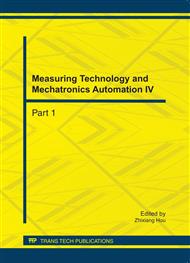[1]
Shen Bo, Zhang Yunfa etc, in: The Damage Engineering Calculation of the Discrete Warhead to the Plane[J]. Journal of Nanjing University of Science and Technology, 2001, 25(4): 373-377.
Google Scholar
[2]
L. Kruszka etc, in: Experimental and computer analyses of impact penetration of a steel rod into heavy plates of steel and alumimum alloys[J]. Engineering Transaction, 2004, 52: 217-230.
Google Scholar
[3]
Andreev V.D. in: Similarity Relations for The Impact Penetration of An Elastic Rod into A Brittle Target[J]. Strength of Materials, 2002, 34: 291-294.
Google Scholar
[4]
S. Chocron etc, in.: Constitutive Model for Borosilicate Glass and Application to Long-rod Penetration[J]. 23th Internation Symposium of Ballistics, 2007: 1073-1081.
Google Scholar
[5]
Th. Behner etc, in: Penetration Dynamics and Interface Defeat Capability of Sillcon Carbide against Long Rod Impact[J]. Int. Journal of Impact Engineering, 2011, 38: 419-425.
DOI: 10.1016/j.ijimpeng.2010.10.011
Google Scholar
[6]
Z. Rosenberg, E. Dekel, in: Further Examination of Long Rod Penetration: The Role Penetrator Strength at Hypervelocity Iimpacts[J]. Int. Journal of Impact Engineering, 2000, 24: 85-102.
DOI: 10.1016/s0734-743x(99)00032-9
Google Scholar
[7]
E. Liden, B. Johansson etc, in: Effect of Thin Oblique Moving Plates on Long Rod Projectiles: A Reverse Impact Study[J]. Int. Journal of Impact Engineering, 2006, 32: 1696-1720.
DOI: 10.1016/j.ijimpeng.2005.02.004
Google Scholar
[8]
Hou Xiucheng, Chen Zhigang, Hao Jia, in: Numerical Simulation and Experimental Investigation of Tandem Shaped Charge Jet[J]. 25th Internation Symposium on Ballistics, 2010: 684-691.
Google Scholar
[9]
H. Hamashima, Y. Kato, S. Itoh, in: Determination of JWL Parameters for Non-ideal Explosive[J]. Shock Compression of Condensed Matter, 2003: 331-334.
Google Scholar
[10]
Wei Jifeng, Li Na, Wen Yuquan, in: Initiation Style Optimization of Aimed Warhead by Numerical Simulation[J]. Journal of Beijing Institute of Technology, 2008, 17(4) : 285-289.
Google Scholar


